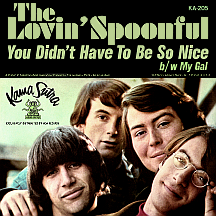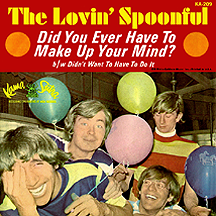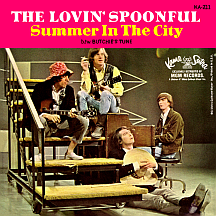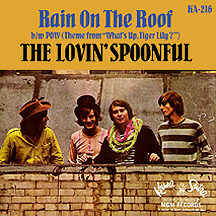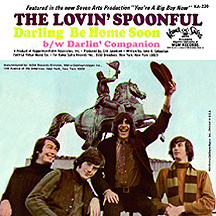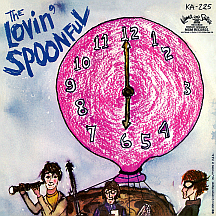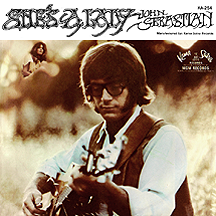THE LOVIN' SPOONFUL
'The doctor said give him jug band music, it seems to make him feel just fine!' For some, that line from The Lovin' Spoonful's "Jug Band Music" sums up what they were all about. But it was just one aspect of a band whose influences came from several different directions. Born and raised in New York's Greenwich Village, a teenage John Sebastian was right in the middle of the folk music scene as it was transitioning to the mainstream in the 1950s. His father, a classical harmonica player, provided another perspective; John took up harp playing, blues style, but found it hard to keep his hands off other instruments. Seeing blues singers perform in the Village was the real "wow" factor, though, and his initial plan as an artist was to explore the form more deeply.
Sebastian met Toronto-born Zal Yanovsky in 1964, a wanderer with experience performing in Canadian coffee houses, at the time a member of short-lived folk-rock group The Mugwumps (which included Denny Doherty and Cass Elliot, later stars with The Mamas and the Papas). Yanovsky's style as a guitarist was all over the place, yet he could comfortably adapt to rock, jazz or blues styles to fit most any situation. He and John hit it off and the band started coming together. Steve Boone joined as bassist. Drummer Joe Butler, formerly with a group called The Sellouts (which included Steve's brother Skip Boone), came on to supply the beat but later made his mark as a vocalist for the group.
Sharecropper Mississippi John Hurt had made several blues recordings for Okeh Records in 1928. A self-taught guitarist in his mid-thirties at the time, he became disenchanted by the lack of interest in his work and returned to his life on the farm. 35 years went by before Hurt's rediscovery resulted in a return to the music business during the last three years of his life, 1963 through 1966. Sebastian saw him perform in the Village (and, it's said, joined him onstage a time or two) and one of Mississippi John's later songs, "Coffee Blues," with its unconventionally structured lyrics '...my lovin' spoon, just my lovin' spoonful...I just got to have my lovin',' inspired the group's name.
The Lovin' Spoonful began appearing at the Night Owl Cafe on West 3rd Street in the Village. Phil Spector stopped by one night and offered to produce them, but aware of Spector's controlling nature with his artists, and preferring more control over their fate, they turned him down. The group's first recordings, "Good Time Music" and "Almost Grown," appeared on a 1965 Elektra album, What's Shakin', alongside selections by The Paul Butterfield Blues Band, Al Kooper, Eric Clapton and the Powerhouse and Tom Rush. The American-based folk-rock explosion that year brought an overabundance of "message" songs with it, but the Spoonful felt they had little to protest about, so it was decided at the beginning that their lyrical content would be purposely nonpolitical and, musically, they would take chances with varying types of original material. NBC-TV and Screen Gems Productions were impressed with the band and considered building a series around them, but they showed little interest (again, preferring artistic freedom) and a group was instead assembled through auditions. That group, of course, was The Monkees, a blockbuster on records, radio and the small screen starting in the fall of 1966.
Kama Sutra Records, an MGM subsidiary, signed the Spoonful and label head Art Kass gave them enough creative rope to succeed...or hang themselves. There was never a period of doubt they would succeed, as the very first single, "Do You Believe in Magic," was a winner. The single featured Sebastian (the song's writer) playing the autoharp, an unusual move for any rock group. With Erik Jacobsen producing, and no other outside contributors, the Lovin' Spoonful unleashed a string of seven top ten hits over a period of a year and a half; following the fall '65 success of "Magic" was the Sebastian-Boone tune "You Didn't Have to Be So Nice" at year's end.
The next two singles, both number two hits, were penned by John and had R&B influences. "Daydream," with an old-timey feel (a whistle-along song) was, of all things, based on what he called the "straight eight" structure of The Supremes' hits "Where Did Our Love Go" and "Baby Love." While the rhythmic similarity is obvious, nothing else about the song suggests a Motown connection. Its flip side, a hot harmonica-and-guitar instrumental called "Night Owl Blues," paid homage to their venue of choice. "Did You Ever Have to Make Up Your Mind?" had a beat and chord progression based on the style of Huey (Piano) Smith and the Clowns (think "Rocking Pneumonia and the Boogie Woogie Flu") with lyrics recalling adolescent twin sisters Sebastian had a crush on while attending summer camp years earlier.
The two top-of-the-chart near misses preceded the Spoonful's signature song, "Summer in the City." Written by John and Steve, reworking an idea John's brother Mark Sebastian had come up with, the finished product depicts a sweltering New York City summer with sound effects of car horns and even a construction site jackhammer effect. It was the number one hit across the nation in August 1966, well-timed for maximum effect. John Sebastian was one of the hottest songwriters around after the group's inital breakthrough: The Beau Brummels took the early Elektra track "Good Time Music" and charted with it in December '65, The Hondells and The Critters released competing versions of "Younger Girl" the following spring and Bobby Darin scored a top 40 hit with "Lovin' You" in early '67.
Many up-and-coming groups were inspired by the "jug band" image of the Lovin' Spoonful despite their definitive direction being harder to define. Onstage they fit the bill as a rock group, Zal's undisciplined antics adding a "fun" flavor to live performances. Musically they were touching on a depth of influences, fearlessly avoiding a sameness of sound from one single to the next. For the first couple of years, everything they tried worked! "Rain on the Roof" in the fall of '66 came closer to a folk vibe than perhaps any of the other hits. Around this time they supplied the film What's Up, Tiger Lily? (an early bit of Woody Allen weirdness wherein he applied a comedic soundtrack to a Japanese detective film) with its opening theme, "Pow." "Full Measure," with Butler on lead vocal, was a straight pop tune, but its countrified flip, "Nashville Cats," an appreciation of all those talented guitar-pickin' southerners (some of them '...yellow Sun record' players from Memphis) became the A side and their seventh consecutive top ten smash in early 1967.
A second film project matched them with another future film legend, director Francis Ford Coppola. You're a Big Boy Now included the title track, instrumental "Lonely (Amy's Theme)" and "Darling Be Home Soon," a top 20 hit, as was the next 45, "Six O'Clock." Then midway through 1967, things began falling apart. Having stayed in the same bag (albeit a successful one) for more than two years, Zal returned to his vagabond ways and left the group (although a drug bust threatening his U.S. residency had something to do with the decision). He had one notable single release, "As Long as You're Here," on the Buddah label as Zalman Yanovsky. Jacobsen was replaced at about the same time by producer Joe Wissert and his first effort was the group's last to make the top 40, "She is Still a Mystery" (written by Sebastian, still obsessing on those twins he knew back at summer camp). Zal's replacement was Jerry Yester (formerly with The New Christy Minstrels and later the Modern Folk Quartet, who recorded for Phil Spector just before breaking up in '66). The brother of The Association's Jim Yester, Jerry fit in well as a writing partner for Sebastian, but that partnership didn't last...Sebastian left in early 1968. His last contribution to the group was "Money," another unique track, this one eschewing drums and instead using a typewriter to carry the beat.
While the group continued without him, Sebastian had a minor solo hit, "She's a Lady," in January 1969, which would have to tide him over for the next seven years. Joe Butler stepped up as lead singer, most conspicuously on the summer '69 chart single "Never Going Back," written by John Stewart of The Kingston Trio. This reconfigured Lovin' Spoonful called it quits later that same year. John Sebastian has found the most lasting success and respect in the years since. His late career highlight was the theme from the TV sitcom Welcome Back, Kotter starring Kabe Kaplan; "Welcome Back" hit number one in May 1976.
NOTABLE SINGLES:
- Do You Believe in Magic - 1965
- You Didn't Have to Be So Nice - 1965
- Daydream /
Night Owl Blues - 1966 - Did You Ever Have to Make Up Your Mind? /
Didn't Want to Have to Do It - 1966 - Summer in the City - 1966
- Rain on the Roof /
Pow - 1966 - Nashville Cats /
Full Measure - 1967 - Darling Be Home Soon /
You're a Big Boy Now - 1967 - Six O'Clock - 1967
- Lonely (Amy's Theme) - 1967
- As Long as You're Here - 1967
by Zalman Yanovsky - She is Still a Mystery - 1967
- Money - 1968
- Never Going Back - 1968
- She's a Lady - 1969
by John Sebastian - Me About You - 1969
- Welcome Back - 1976
by John Sebastian


